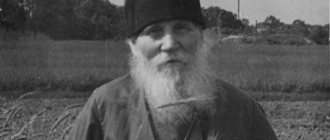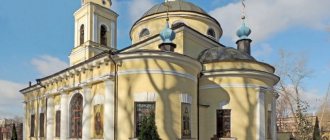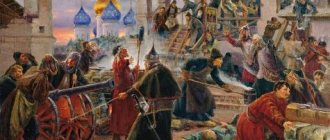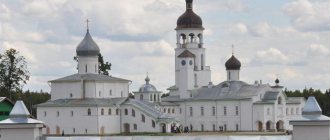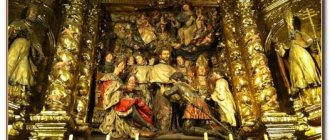This year, North Ossetia celebrates the 1100th anniversary of the baptism of Alania (historical Ossetia). However, about half of the republic’s residents call themselves Orthodox, and almost a third (29%) of the population considers themselves to be part of the traditional, pre-Christian Ossetian faith of Uatsdin.
At the end of July, a member of the youth parliament of North Ossetia, Ruslan Gabaraev, demanded that the Orthodox Christians of the republic “get out along with their priests and crosses.” In response, Archbishop Leonid of Vladikavkaz and Alan said that he would not allow Ossetia to return to the “stone age of paganism,” and local Orthodox Christians complained of many years of persecution by “neopagans.”
What is the Uatsdin religion, when did it appear and what its adherents think about, “Such Matters” looked into it.
Photo: A. Shapiro / RIA Novosti
North Ossetia-Alania was baptized in 916 and 1754
The great baptism of Alania (as North Ossetia was called in ancient times) took place in 916. It was then that Patriarch Nicholas the Mystic of Constantinople established the Alan diocese.
Three Alan temples dating back to the 9th - 10th centuries have survived to this day. These are the oldest Christian churches located in Russia. It should be noted that Christianity brought writing to the Ossetian land.
Northern Zelenchuk Temple of the 10th century. The oldest Christian churches in Russia are located on the territory of Ossetia
In the 4th quarter of the 13th century, the Zikh and Alan metropolises united, which led to the departure of Christians to the Sarai metropolis.
After Byzantium fell and the Alanian state collapsed as a result of raids by nomads, its population was almost completely destroyed by barbarians. As a result, Christianity regressed to a folk custom.
1745
this year Ossetia was baptized for the second time
The population of Ancient Alanya consisted not only of Christians, but also Muslims.
In the spring of 1745, headed by Archimandrite Pachomius, the Ossetian Russian Orthodox Ecclesiastical Commission arrived in Ossetia. As a result, Ossetia was baptized a second time.
The new baptism must be viewed as an act of political loyalty to Russia.
What other religions exist in Ossetia
In South Ossetia you can often meet adherents of Judaism. This feature is due to the fact that Jews have lived in this part of the state for a long time. Before the 1917 revolution, there were about a dozen synagogues in the capital Tskhinvali. Now the number of such sacred places has decreased many times.
The following religions are least common in Ossetia:
- Buddhism;
- Catholicism;
- Protestantism.
Recent studies have shown that a minimal number of people in this country (3%) are atheists and do not adhere to any religious beliefs. Among Ossetians there are also those who believe in God, but do not profess anything (1%).
For a long time Ossetia belonged to the jurisdiction of the Astrakhan diocese
From 1602 to 1829, the North Caucasus, including Ossetia, in church and administrative terms, was part of the Astrakhan diocese.
At the same time, Christianity began to spread among the Caucasian peoples only after the formation in 1745 of the Ossetian Spiritual Commission, which worked in Kizlyar and Mozdok.
Bishop Gaius (Georgiy Takaov). The bishop headed the Mozdok vicarage of the Astrakhan diocese in 1793-1799
From 1793 to 1799, the Mozdok Vicariate of the Astrakhan Diocese operated under the direction of Bishop Gaiya (Takova).
He was instructed to fulfill all the duties assigned to the Spiritual Ossetian Commission and transferred to everyone the existing and under construction temples and monasteries in Mozdok, Kizlyar and Ossetia itself.
In 1811, the Georgian Exarchate of the Russian Orthodox Church was established. In addition, another four years later, the Ossetian Spiritual Commission began its activities in Tiflis.
She conducted missionary activities in the territory of North and South Ossetia, as well as in the territory of Abkhazia and Dagestan.
In 1817, she was subordinated directly to the Exarch of Georgia.
In 1836, a school for Ossetian children was opened in Vladikavkaz, which prepared them to work as priests of Ossetian parishes, as well as as missionaries or preachers.
An old faith of Ossetians
The ancestors of modern Ossetians were pagans who worshiped patron spirits and made sacrifices to them. At the same time, they recognized the existence of one God. The ancient Ossetians considered spirits as helpers, by appeasing them you could get what you wanted. The Almighty in their repose is a perfect personality incomprehensible to the human mind, who is the creator of everything on earth and in heaven.
The ancient Ossetians did not leave behind any places of worship, idols or religious books. Their beliefs were based on the unity of man and nature. Sacred holidays were held not in temples, but in the open air. The Ossetians did not have religious leaders to whom everyone had to obey. Instead, elders were appointed who passed on their wisdom and accumulated knowledge to new generations.
During the period of paganism, Ossetians regularly held religious celebrations. Such celebrations took place in the form of general feasts, in which representatives of different classes gathered at one table. While eating national dishes, people had conversations about spirits, powerful saints called Ossetian dzuars, communication with them, and secret knowledge received from ancient ancestors.
Paganism and related rituals still exist in the territory of modern Ossetia. Today, about 28% of the inhabitants of this country consider themselves pagans, who preserve and observe the main traditions of the ancient folk religion.
In the 19th century, all Ossetian parishes were united
In the 40s of the 18th century, the military situation in the Caucasus worsened and therefore it was necessary to raise the work of the Spiritual Mission in Ossetia to a high level.
That is why in 1856 the Exarch of Georgia united the parishes of North Ossetia under the leadership of the senior dean; he also became a missionary. In addition, in 1860, the Society for the Restoration of Orthodox Christianity in the Caucasus was established.
Badge of the Society for the Restoration of Orthodox Christianity in the Caucasus, IV degree. The society set as its goal the fight against sectarianism and paganism in the Caucasus
Joseph was appointed archimandrite and initially his residence was the village of Alagair, and in 1861 - 1869 Vladikavkaz.
The archimandrite was actively involved in education, preached in the Ossetian language, compiled the Ossetian alphabet for parish schools, and began work on a Russian-Ossetian dictionary. Thanks to his efforts, the Vladikavkaz Ossetian girls' school was founded in 1863.
Archimandrite Joseph actively preached in the Ossetian language.
On April 3, 1875, Emperor Alexander II issued a decree establishing the Vladikavkaz vicarage. Its jurisdiction extended to churches and clergy in the city of Vladikavkaz and the Alagir plant.
Archimandrite Joseph (Chepigovsky) became the bishop of Vladikavkaz. In the first years of its existence, the Vladikavkaz Vicariate included 20 parishes (by 1881 - 24 parishes); more than 30 Orthodox schools operated in Ossetia.
Military-Ossetian road. Alagir. Silver-lead plant. 1866 The Vladikavkaz vicarage, established in 1785, extended its jurisdiction to the Alagir plant
In 1885, the Vladikavkaz vicarage was transformed into the Vladikavkaz diocese. This happened as a result of the reorganization of the Caucasian and Ekaterindar diocese.
Stavropol was appointed its center. At the same time, the Terek region was removed from the diocese, including its composition in the newly formed Vladikavkaz diocese.
His Grace Joseph (Chepigovsky), nicknamed “Apostle of Ossetia”
The Vladikavkaz and Mozdok diocese existed from 1885 to 1922. On September 10, 1894, she was removed from the subordination of the Exarch of Georgia.
It must be remembered that initially the Terek region was included in the territory of the diocese. Later, the Dagestan region and the Ossetian village of Novogeorgievskoye, Kuban region, were annexed to it.
Vladikavkaz. Cathedral of the Archangel Michael. From 1863 to 1893 he was part of the Vladikavkaz department
At the beginning of the twentieth century. the territory of the diocese included modern North Ossetia, Kabardino-Balkaria, Dagestan, Chechnya, Ingushetia and the Caucasian Mineral Waters region.
Cathedral city - Vladikavkaz. Cathedrals - Vladikavkaz Spaso-Preobrazhensky (1863-1893) and Michael-Arkhangelsk (since 1894), Uspensky in Mozdok (since 1894).
In 1910-1914. The Pyatigorsk Vicariate existed as part of the Vladikavkaz diocese.
His Grace Joseph (Chepigovsky) was nicknamed “the apostle of Ossetia.”
Orthodox Ossetia especially remembers the activities of His Grace Joseph (Chepigovsky) for his spiritual exploits. At the same time, he worked in difficult conditions, because the Ossetian mountain parishes were small and poor.
In addition, a feature of the Vladikavkaz diocese was that the number of Orthodox Christians living on its territory (about 300 thousand people in the early 90s of the 19th century) was less than the number of Muslims (about 400 thousand people) , as well as sectarians and Old Believers (the latter lived, in particular, in the Kizlyar department, the village of Chervlennaya, Essentuki).
Bishop Joseph translated the Holy Scriptures and church texts into the Ossetian language. He contributed a lot to the development of education in Ossetian.
Through his efforts, books in the Ossetian language were published in Vladikavkaz starting in 1881. Among them are: “Primer”, “Sacred History”, multi-volume “Russian-Ossetian Dictionary with Brief Grammar”, etc.
136 temples
numbered in the diocese by 1889
By 1889, Bishop Joseph, at his own request, was retired. At that time, there were 136 churches in the diocese. Orthodox Ossetians still remember the “Ossetian Apostle” with kind words.
Specifics of Ossetian beliefs
Ossetians, Muslims or Christians, those who profess traditional religion or other movements, they all remain one united people, tolerant of other cultures and at the same time committed to their ancient values.
God is one for everyone—that’s what the ancients thought, that’s what the elders teach. And to this day, the Ossetian people are very tolerant of a variety of religions.
The culture of the Ossetian people has evolved over centuries. Its unique features are largely determined by religious motives.
Primitive religion formed among the ethnic group respect for women, veneration for the older generation, attentive attitude to nature, hospitality, etc.
These principles were reinforced by Islam, which also influenced the formation of management principles, the desire for self-education and self-improvement.
The influence of Christianity made its own adjustments to the life of the people through rituals and adjustments to the holiday calendar.
Various religions that came to the land of the Irons left their contributions to the development of art.
It is difficult to distinguish between the influence of individual religions on specific aspects of Ossetian culture. However, we can confidently say that the culture and religion of this people go hand in hand and complement each other.
From 1900 to 1913, the Vladikavkaz and Mozdok diocese actively developed
In 1894, the Vladikavkaz and Mozdok diocese separated from the Georgian Exarchate. This happened thanks to the activities of Bishop Vladimir (Sinkovsky), transferred from the Altai spiritual mission.
As a result, the boundaries of the diocese expanded, and a spiritual consistory began to operate under it. In 1895, the Vladikavkaz diocese was divided into 13 deanery districts.
Archbishop Vladimir. 5th Bishop of Vladikavkaz and Mozdok. Thanks to his missionary activities, the Vladikavkaz and Mozdok diocese separated from the Georgian Exarchate
Through his efforts, the Ardon Ossetian Theological School was transformed into the Alexander Theological Seminary.
At the same time, the bishop also in 1895 established at the seminary a department of the diocesan school council for the management of parochial schools in North Ossetia.
On January 1, 1895, the first issue of the Diocesan Gazette was published. Books and brochures with religious and moral content were also distributed in the diocese.
In 1902, the Gospel was published in the Ossetian language.
In 1894, through the efforts of Bishop Vladimir, 2,000 fugitive Cossacks joined the Orthodox Church. And in subsequent years, missionary work became the main activity of the diocese.
On September 22, 1910, the Pyatigorsk Vicariate was established to help the Vladikavkaz bishop. Arseny (Smolenets) became its bishop.
On December 22, 1913, Bishop Antonin (Granovsky), later a famous figure in renovationism, was appointed to the Vladikavkaz See. At this time, a massive transition of Orthodox Christians to Baptists and other sects began in the diocese.
Bishop Antonin (Granovsky) 9th Bishop of Vladikavkaz and Mozdok. A prominent figure in the schism and renovationism. Under him, a massive transition of Orthodox Christians to Baptists and other sects began in the diocese.
The Vladikavkaz clergy recognized the Provisional Government and the Whites, but did not recognize the Reds
During the revolutionary events of 1917, the Vladikavkaz clergy accepted the Provisional Government. It did not recognize Soviet power.
When Vladikavkaz was taken by Denikin’s army in 1919, representatives of the diocese welcomed it. When Soviet power was established and consolidated in the North Caucasus in 1920, Bishop Macarius fell under a revolutionary tribunal, the diocesan council was dissolved, and the confiscation of church valuables began.
Bishop Macarius (Pavlov). 10th Bishop of Vladikavkaz and Mozdok. After Vladikavkaz was occupied by the Reds in 1922, he deviated into renovationism and began to be called “Pyatigorsk”
At the end of August 1922, Bishop Macarius deviated into renovationism and therefore began to be called “Pyatigorsk”. Most of the clergy followed him.
In 1943, all Orthodox parishes of the former Terek and Dagestan regions became part of the Stavropol diocese.
March 22, 2011
The Vladikavkaz and Alan diocese has been restored
Since the mid-20th century, the Stavropol and Baku diocese has operated on the territory of North Ossetia, and the Stavropol and Vladikavkaz diocese has operated since 1991.
The Vladikavkaz and Alan diocese was restored on March 22, 2011. It included parishes and monasteries in the republics: North Ossetia - Alania, Dagestan, Ingushetia, Chechnya.
In addition, Orthodox Christians from South Ossetia are also spiritually nourished here.
Temples[edit]
The main temples of North Ossetia-Alania
Cathedral of the Ascension of the Lord (Alagir)[edit]
The single-domed, three-altar Church of the Ascension, made of pink tuff, was built in the Byzantine style according to the design of the architect Grigory Gagarin in the newly formed settlement at the Alagir silver-zinc plant.
On October 22, 1853, the Holy Ascension Cathedral was solemnly consecrated in the presence of the head of the Vladikavkaz district, Major General Vrevsky, by His Eminence Isidore, Archbishop of Kartalin and Kakheti, Exarch of Georgia, with a large gathering of believers from the surrounding villages and villages.
The temple was closed in 1927, the building housed a local history museum.
In 1989 it was returned to believers, restoration was completed by the early 2000s.
Address
: 363240, Republic of North Ossetia-Alania, Alagir, st. Alagirskaya, 62.
Telephone
: 8 (86731) 2-36-60.
Church of St. George the Victorious (Ardon)[edit]
In 1885, by the decision of a gathering of Cossacks from the village of Ardonskaya, it was decided to build a five-domed stone church on the site of an old wooden church.
On May 13, 1901, the temple was consecrated in honor of St. George the Victorious. After the revolution, the temple was closed, and for many years it housed a granary.
In 1942, after the Germans left Ardon, services resumed.
Address
: 363300, Republic of North Ossetia-Alania, Ardon, st. Partizanskaya, 32.
Telephone
: 8 (86732) 3-20-31.
Church of the Life-Giving Trinity (Gornaya Saniba)[edit]
The temple in honor of the Holy Trinity in the village of Gornaya Saniba was built in the 12th century.
During the Tatar-Mongol invasion it was destroyed and restored only at the end of the 18th century.
After 1917, the ancient shrine was again destroyed and restored several years ago from ruins through the efforts of Mairbek Kusaev, a native of this village.
On June 12, 2006, the first patronal feast day was celebrated in the Holy Trinity Church in the village of Gornaya Saniba after a long break.
For the patronal feast, Deacon Nikolai Lukyanov completed the painting of the temple, an iconostasis made in Volgodonsk was installed, a refectory was built, and the temple grounds were landscaped.
On the territory adjacent to the temple, a building was built to receive pilgrims and a memorial complex was erected to the victorious soldiers with a sculpture of a mourning mountain woman with a burqa in the hands of Stanislav Tavasiev.
Address:
Republic of North Ossetia-Alania, Prigorodny district, village of Saniba (Gornaya Saniba)
North Ossetia in our time is one of the centers of Orthodoxy in the Caucasus
North Ossetia and the Vladikavkaz and Alan diocese itself is one of the recognized centers of Orthodoxy in the Caucasus. Currently, the diocese has about 50 chapels and churches, three monasteries, spiritual educational and children's rehabilitation centers.
Orthodox gymnasium named after Akso Koliev, located on the territory of St. George's Cathedral in Vladikavkaz. This is the first and only Orthodox gymnasium in the diocese that gives students the opportunity to receive an education in accordance with state educational standards
In addition, the Orthodox gymnasium named after Akso Koliev operates in the diocese. It was opened on November 16, 2005.
This is the first and only Orthodox gymnasium in the republic, which provides students with the opportunity to receive education in accordance with state educational standards.
The national dance ensemble “Arv”, the choir “Blagovest”, and the design and research society of students “Kladez” work under it.
Places of power
Over the past 20 years, two new monasteries have appeared in North Ossetia - the Alansky Assumption Monastery in the village of Khidikus and the Alansky Epiphany Monastery in Alagir. The inhabitants moved here from Beslan. The construction of new hermit parishes was blessed by an elder from the Rila Monastery. His instructions turned out to be correct. The monasteries became the spiritual centers of Christianity in North Ossetia.
An abandoned boarding house was allocated for the convent not far from one of the regional centers of North Ossetia - the city of Alagir. Over the course of 15 years, instead of mountains of garbage and destroyed buildings, a temple, a hotel, a monastery workshop, a refectory and a rehabilitation center for children injured in terrorist attacks appeared. The former TV director, Mother Nonna, became the abbess of the monastery. Every year thousands of believers are baptized in the waters of the monastery lake.
On the Feast of the Epiphany of the Lord people also gather at the Assumption Monastery. The ceremony is carried out in the waters of the mountain river Fiagdon. Hundreds of pilgrims from all over the country come here every year to seek blessings from all over the country.
Now there are 12 monks in the men's monastery. And the revival of Christianity in this gorge began with two inhabitants. The place was not chosen by chance. In a chapel not far from the monastery, one of the most valuable Christian relics, the Iveron Icon of the Mother of God, was kept for several centuries. It was presented to believers by the Queen of Georgia Tamara.
After the services, the pilgrims do not leave for a long time. Guests of the monastery are invited to a meal. They are treated to natural products of their own production and tea made from mountain herbs.
Archbishop of Vladikavkaz and Alan Leonid (Gorbachev) - an outstanding Orthodox missionary
The diocese is headed by Archbishop of Vladikavkaz and Makhachkala Leonid (Gorbachev). He was born on October 26, 1968 in Stavropol. He graduated from high school in Krasnodar in 1985.
After that, he worked as a laboratory assistant at the department of aerodynamics and flight dynamics in the military unit 26265. In parallel with his work, he served as a sexton of the St. George Church in Krasnodar.
Archbishop of Vladikavkaz and Alan Leonid (Gorbachev). Currently, Father Leonid leads the diocese. He is known as a missionary and has received ecclesiastical and secular awards.
After serving in the army in 1988 - 1989, he became a reader-singer of the St. George Church in Krasnodar, as well as a subdeacon of Bishop Isidore of Ekaterinodar and Kuban. Then he studied at the Leningrad Theological Seminary. In 1990 he was ordained a deacon.
Archbishop Leonid (Gorbachev) became an archimandrite on April 11, 2010. In the same year he was tonsured a monk and ordained a hieromonk.
From 1990 to 1997, he first served as a full-time clergyman of the Catherine Cathedral in Krasnodar, and later as a clergyman.
After this, Father Leonid became an employee of the Synodal Department for interaction with the Armed Forces and law enforcement agencies in Moscow. In this capacity, he participated in many missionary trips, including to the “hot spots” of the planet.
Awarding Bishop Leonid with the Order of St. Mark the Apostle of the highest degree and a memorial panagia. He was also awarded other ecclesiastical and secular awards.
On April 11, 2010, he was elevated to the rank of archimandrite. On December 4, 2017, he became archbishop. He was Bishop of Argentina and South America, Bishop of the Patriarchal Residence of the St. Daniel Monastery.
He became Bishop of Vladikavkaz and Alan on June 3, 2021, and on July 28, 2021 he was appointed rector of the Cathedral of the Holy Great Martyr and Victorious George in the city of Vladikavkaz. Awarded secular and ecclesiastical orders.
Content
- 1 Cathedral of the Ascension of the Lord (Alagir)
- 2 Temple of St. George the Victorious (Ardon)
- 3 Church of the Nativity of the Blessed Virgin Mary (Digora)
- 4 Temple of the Life-Giving Trinity (Gornaya Saniba)
- 5 Temple of the New Martyrs and Confessors of the Russian Church (Beslan)
- 6 Holy Assumption Cathedral (Mozdok)
- 7 St. Nicholas Church (Novoossetinskaya)
- 8 Temple of the Savior Not Made by Hands (Pavlodolskaya)
- 9 St. George's Cathedral (Vladikavkaz)
- 10 Temple of the Prophet Elijah (Vladikavkaz)
- 11 Church of the Nativity of the Blessed Virgin Mary (Vladikavkaz)
- 12 Holy Intercession Church (Vladikavkaz)
- 13 Church of St. Equal to the Apostles Nina (Vladikavkaz)
News of the Vladikavkaz and Alan diocese can be found on the diocesan website
The Vladikavkaz and Alan diocese lives an active life. News about it can be found by visiting the official website of the diocese.
Official website of the Vladikavkaz and Alan diocese
Here you can find information about both the history of the diocese and its modern life.
For example, from the latest news we can mention the congratulations of His Holiness Patriarch Kirill of Moscow and All Rus' to Archbishop Leonid on the anniversary of his enthronement.
In addition, in the news section you can also learn about the progress of construction and restoration work in the diocese.
By leaving a comment, you accept the user agreement

